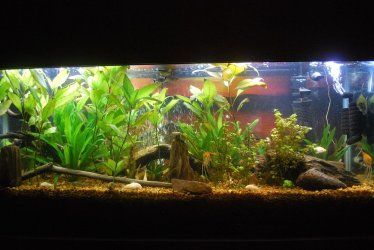I started to ask questions about this on someone else's thread, so decided I could learn more about it and started this thread.
It was said by some very experienced people that a fully planted tank does not need a filter with bio-media in it. It was also said that in doing a planted cycle that no ammonia added is needed.
So I do need some clarification on all this as I am still a bit confused, I believe the reason is all this is going against most of what I have learned over the past five years I have been fish keeping. Kinda hard to go against the grain of what I have already learned.
So in doing a planted cycle, the fish are supposed to be the ammonia source, correct, or am I misunderstanding this. This means a fish in cycle, which goes against my feelings of subjecting fish to ammonia and nitrite poisoning. I don't do fish in cycles, I do fish-less cycling only. So in a planted cycle the plants are supposed to take the load and absorb those dangerous gasses protecting the fish. I do know that a person should under this planted only cycle add a few fish at a time and I understand this.
Here is my tank and present stock. The tank as been up and running now for over six months. Picture below.
55 gallon/ 208 liter tank.
Two large veil tail Angel fish.
10 Red Eyed Tetras
2 Bristle Nosed Plecos
10 assorted snails.
7 albino cories.
Some one also suggested that I could take down and remove my canister filter as it may no longer be needed. I really need more input about this before I do.
This picture was taken three months ago, and the plants have literally taken over by now.

It was said by some very experienced people that a fully planted tank does not need a filter with bio-media in it. It was also said that in doing a planted cycle that no ammonia added is needed.
So I do need some clarification on all this as I am still a bit confused, I believe the reason is all this is going against most of what I have learned over the past five years I have been fish keeping. Kinda hard to go against the grain of what I have already learned.
So in doing a planted cycle, the fish are supposed to be the ammonia source, correct, or am I misunderstanding this. This means a fish in cycle, which goes against my feelings of subjecting fish to ammonia and nitrite poisoning. I don't do fish in cycles, I do fish-less cycling only. So in a planted cycle the plants are supposed to take the load and absorb those dangerous gasses protecting the fish. I do know that a person should under this planted only cycle add a few fish at a time and I understand this.
Here is my tank and present stock. The tank as been up and running now for over six months. Picture below.
55 gallon/ 208 liter tank.
Two large veil tail Angel fish.
10 Red Eyed Tetras
2 Bristle Nosed Plecos
10 assorted snails.
7 albino cories.
Some one also suggested that I could take down and remove my canister filter as it may no longer be needed. I really need more input about this before I do.
This picture was taken three months ago, and the plants have literally taken over by now.



